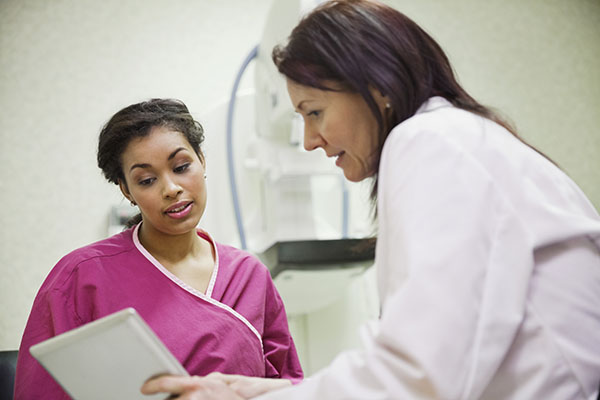 “Breast cancer is the most common type of cancer affecting women in the U.S. today,” says Kristin Krupa, MD, Trinity Health Mid-Atlantic breast surgeon. “About one in eight women are going to develop breast cancer in the course of their life.”
“Breast cancer is the most common type of cancer affecting women in the U.S. today,” says Kristin Krupa, MD, Trinity Health Mid-Atlantic breast surgeon. “About one in eight women are going to develop breast cancer in the course of their life.”
One of the easiest and most important ways for a woman to detect breast cancer in its earliest stages is by scheduling an annual screening mammogram.
“We recommend starting your annual mammogram appointments beginning around the age of 40,” Dr. Krupa says. However, if you have a family history of breast cancer your doctor should evaluate you and see if you qualify to start screening mammograms before age 40.
“Most women who are diagnosed with breast cancer do not have a strong family history, which means it’s that much more imperative for a woman to prioritize the need for a mammogram,” Dr. Krupa explains. “When breast cancer is diagnosed in its earlier stages, there tends to be a higher success rate for treatment options.”
While a mammogram can detect various forms of breast disease, it is most commonly used to check for cancerous lumps.
One of the easiest and most important ways for a woman to detect breast cancer in its earliest stages is by scheduling an annual screening mammogram.
A screening mammogram is a routine and straightforward procedure. A specially trained breast radiology technician will take images of each breast individually by positioning it between two plastic plates and flattening it. The patient must hold her breath and remain still while the images are recorded.
The entire appointment takes approximately fifteen minutes. Results are interpreted by a radiologist who specializes in breast disease. Results are typically available within 72 hours. Most mammogram results do not require follow-up; however, the following findings would likely require further diagnostic testing:
- the presence of a new mass
- a mass with irregular or speculated-looking edges
- calcifications
If a patient does need additional testing after a screening mammogram, this may include a diagnostic breast ultrasound, diagnostic mammogram or a breast MRI. This can help evaluate if the mass and/or calcifications are benign or concerning to be cancerous.
“Sometimes the only way to know if there is cancer in the breast is not based on imaging but rather through a breast biopsy performed by a breast radiologist,” says Krupa. “This is when the tissue is removed and evaluated by a pathologist.”
If cancer in the breast is found, our providers will work with the patient to create a personalized treatment plan that fits the person’s needs. Learn more about the St. Mary Complete Breast Care Team.
Schedule Your Mammogram Online
Schedule a screening mammogram online. No referral needed. Choose one of our locations below.
